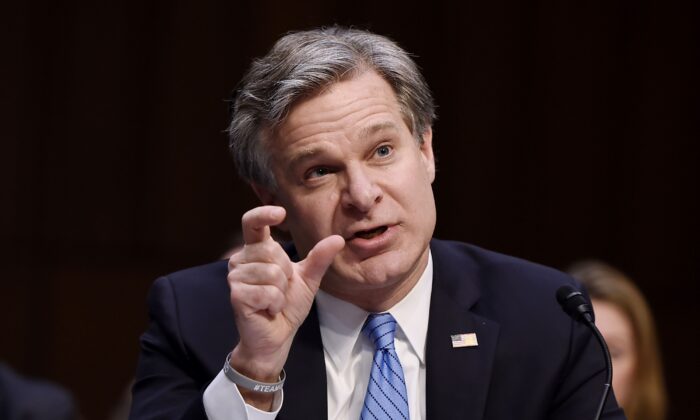FBI Director Christopher Wray told a House panel on national security threats that no single organization or ideological affiliation represents the biggest risk but, instead, it is individuals who self-radicalize online and carry out attacks that pose the most serious threat to the homeland.
At Thursday’s hearing before the House Homeland Security Committee, Wray was asked by Rep. Bennie Thompson (D-Miss.) whether the greatest domestic threat to homeland security was posed by right-wing or left-wing extremism.
Wray responded by saying the biggest danger comes from people who become radicalized online and then carry out lone-wolf attacks against poorly defended targets.
“We assess that the greatest threat to the homeland, to us here domestically, is not one organization, certainly not one ideology, but rather lone actors largely self-radicalized online who pursue soft targets using readily accessible weapons,” Wray said. “Those include both domestic violent extremists of a variety of sorts, as well as homegrown violent extremists who are motivated by foreign jihadist type sources.”
He said that unlike Al-Qaeda-type sleeper cells, with respect to which investigators can more easily “connect the dots” and uncover them as they prepare and communicate, lone actors are much harder to identify before they strike.
“These people—both categories, the domestic violent extremists and the homegrown violent extremists—they don’t have a lot of people they’re working with,” Wray said, adding, “they don’t take a lot of planning and preparation, they can go from radicalization to mobilization in weeks if not days.”
“The time, as experts say, from flash to bang, is that much more daunting” with respect to lone actors, he said.
Thompson then asked about claims that Antifa has been alleged to be the biggest domestic threat on the left, to which Wray replied by saying that the FBI does not look at threats in terms of political affiliation, but their potential to do harm.
“We don’t really think of threats in terms of left and right at the FBI. We’re focused on the violence, not the ideology,” he said, adding that domestic violent extremists include “everything from racially-motivated violent extremists” to “anti-government, anti-authority extremism, and that includes people ranging from anarchist violent extremists—people who subscribe to Antifa or other ideologies, as well as militia types.”

In prepared remarks, Wray elaborated on the targets chosen by lone-wolf type attacks.
“Many of these violent extremists, both domestic and international, are motivated and inspired by a mix of ideological, sociopolitical, and personal grievances against their targets, which recently have more and more included large public gatherings, houses of worship, and retail locations. Lone actors, who by definition are not likely to conspire with others regarding their plans, are increasingly choosing these soft, familiar targets for their attacks, limiting law enforcement opportunities for detection and disruption ahead of their action,” he said in the statement.
Testifying before the committee, Wray said that in seeking to counter threats to national security, the FBI focuses on “disruption, on making arrests before a criminal can act.”
“Just this year alone, through the hard work and dedication of countless men and women both at the FBI and across our partner agencies, we’ve successfully thwarted potential terrorist attacks in Kansas City, Tampa, Cleveland, Oklahoma City, Boston, Phoenix, and other locations,” Wray said.
He said, in the context of recent protests, that the FBI has launched investigations against people involved in criminal activity.
“Although the majority of protesters have been peaceful, we have opened investigations on individuals involved in criminal activity at these protests, some of who adhere to violent, extremist agendas designed to sow discord and upheaval,” he said, adding that the bureau does not investigate people based on their ideology or on the basis of what they express under the constitutionally-protected right to free speech.
“But when the ideology leads someone to commit criminal acts and pursue violence, the FBI will not hesitate to take appropriate action,” he said.
Asked about Antifa as an organization, Wray said, “we look at Antifa as more of an ideology or a movement than an organization. To be clear, we do have quite a number of properly predicated domestic terrorism investigations into violent anarchist extremists, any number of whom self-identify with the Antifa movement, and that’s part of this broader group of domestic violent extremists,” adding that investigations are also ongoing into “racially-motivated violent extremists, the militia types, and others.”
Wray’s testimony follows a report from a nonprofit that studies how hate-charged messages spread across social media, which found that far-left groups are increasingly using memes and other online propaganda to instigate violence against members of the general public and police.
In a report, the Network Contagion Research Institute (NCRI) concluded that anarcho-socialist and violent anarchist online communities have grown in influence in recent years, and found evidence that “violent anarcho-socialist networks played an active online role in preparing for and coordinating real world riots nation-wide and in real time.”
It comes at a politically sensitive time, when peaceful protests for police reform and other causes have been marred by outbreaks of looting and violence.
Focus News: Biggest Domestic Threat Is Lone Attackers Self-Radicalized Online: FBI Director
Young Child Found Dead After Driver Reports Seeing a Doll on Interstate
